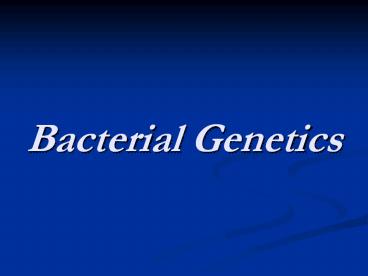Bacterial%20Genetics - PowerPoint PPT Presentation
Title:
Bacterial%20Genetics
Description:
Title: Bacterial Genetics Author: g-max Last modified by: uoj Created Date: 10/16/2004 12:40:04 PM Document presentation format: On-screen Show Other titles – PowerPoint PPT presentation
Number of Views:222
Avg rating:3.0/5.0
Title: Bacterial%20Genetics
1
Bacterial Genetics
2
- The rapid development of molecular genetics, in
conjunction with the ability of scientists to
manipulate and transfer genes, has elicited
considerable interest among physicians,
scientists, and the public in general. - The ability to manipulate the hereditary material
of microorganisms and even our own species has
far reaching consequences.
3
Gene Mutation
- Any change in the nucleotide sequence of a gene.
- It may result from base substitutions,
deletions, insertions and rearrangement. - Transition Vs transversion of nucleotides
- Mismatch repair by proof reading enzymes (SOS
system) - Mutations in bacterial populations can pose a
problem, bacteria have mechanisms by which genes
can be transferred to other bacteria. Thus, - a mutation arising in one cell can be passed
on to other cells.
4
Types of Mutation
- 1) Silent mutation
- 2) Missense mutation
- 3) Nonsense mutation
- 4) Frame-shift mutation
- 5) Null mutation
- 6) Suppressor mutation (intragenic or
- extragenic)
5
Spontaneous Mutation
- 10-4 (hot spots) to 10-11. Generally 10-7 in
progeny of a single cell. - Mechanism electrochemical rearrangement, or
moving around of electrons in the nucleotide
molecule. - Shift from a keto state to the enol form
- ( tautomerization) promotes abnormal hydrogen
bonding between nucleotides. - Thymine (keto) ? adenine
- Thymine (enol) ? guanine
6
Induced Mutation
- Mutagens (Chemical and Physical agents)
- Chemical Agents
- 5-Bromouracil analogue of thymine binds to G.
- 2-Aminopurine analogue of adenine binds to C.
- Nitrous acid (HNO2) Nucleotide deamination
- Alkylating agents (eg ethyl-methyl sulfonate)
- Acridine dyes (Proflavin) insertion or deletion
leading to frame-shift mutation.
7
- Physical Agents
- Heat deamination of nucleotides.
- UV light Pyrimidine dimmers (thymine), hydrated
pyrimidines. - Gamma and x-rays breaks in the sugar phosphate
backbone.
8
Gene Transfer
- Transfer of DNA from a donor cell to a recipient
cell with the resultant recombination. - Gene transfer in bacteria is unidirectional
- Donor ? recipient
- It requires DNA homology
- A small part of DNA is transferred
- It is achieved by three mechanisms
Transformation, Transduction and Conjugation.
9
Transformation
- Uptake of naked fragmented single stranded DNA
- Most primitive mechanism of gene transfer
- It occurs in only a few genera
- Bacillus subtilis
- Streptococcus pneumoniae
- Hemophilus influenzae
- Neisseria gonorrhea
- E. coli (in the presence of a high
concentration of calcium salts and high
temperature)
10
- The probability that transformation has
contributed much to genetic variety is very
small. - Factors affecting transformation
- - DNA size and state
- - Competence of the recipient
- Steps
- - Uptake of DNA
- - Legitimate/Homologous/General
- recombination
11
Transduction
- Transfer of DNA via a bacteriophage
- Lytic Vs lysogenic (temperate) phage life cycle.
- Restricted Vs generalized transduction
- Not affected by nucleases in the environment
- Phages that mediate generalized transduction
generally breakdown host DNA into smaller pieces
and package their DNA by a "head-full" mechanism. - Examples diphtheria toxin, erythrogenic toxin
and resistance to penicillin in staphylococci.
12
Phage Composition and Structure
13
Plasmid- Mediated Conjugation
- PIASMIDS
- - Circular ds DNA molecules ranging in size
- from 1/1000 to 1/10 of the chromosome.
- - They are usually autonomous (replicons).
- - As few as 1 to as many as 100/cell.
- - May become integrated (episomes).
- - Two classes conjugative and
nonconjugative
14
Conjugation
- Requires the sex (F) factor
- Donor cell (F) and recipient cell (F- )
- F factor is a ds DNA that is 1/40 of the
chromosome in size, not under the control of the
bacterial chromosome, ant it can replicate
autonomously. - It possesses several genes that code for the
formation of sex pili.
15
Conjugation
- During the conjugation process, a copy of the sex
factor is made and one of its (single) strands is
transferred to the recipient cell. - The complementary strand of the donor single
strand is synthesized in the recipient cell which
is now converted to an F cell.
16
Mechanism of F x F- Crosses
- Pair formation
- Conjugation bridge
- DNA transfer
- Origin of transfer
- Rolling circle replication
17
Physiological States of F Factor
- Integrated (Hfr)
- Characteristics of Hfr x F- crosses
- F- rarely becomes Hfr while Hfr remains Hfr
- High transfer of certain donor chromosomal genes
18
- Functions of Plasmids
- R Plasmids Antimicrobial resistance, may be
multiple but clustered. - Resistance to heavy metals (Ag, Co, Hg) in
Staphylococci, coexist with R plasmids. - Virulence determinants toxins
- Bacteriocinogenic plasmids
19
- Mechanisms of Action of Resistance plasmids
- Modification of antibiotic
- Alteration of target site
- Alteration of uptake
- Replacement of a sensitive pathway
20
Transposable genetic Elements
- Move from one location to another (jumping genes)
- 1) Random movement (not totallypreferable
sites) - 2) Not capable of self replication
- 3) Transposition mediated by site-specific
- recombination (mediated by transposases)
no - homology is required
- 4) Transposition can be accompanied by
duplication
21
- Types
- 1) Insertion sequences (Is) Small stretches
of - DNA that have at their ends repeated
- sequences
- 2) Transposons (Tn) Carry extra genes
22
Genetic Engineering
- Cloning (recombinant DNA)
- - RE sticky ends (passenger DNA)
- - RE sticky ends (vector DNA) of plasmids
- - Annealing (ligase)
- - Insertion to a cell (transformation)































